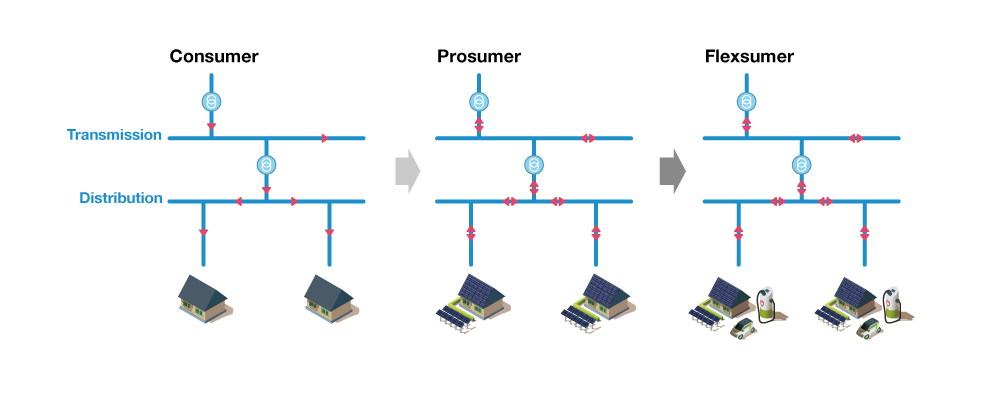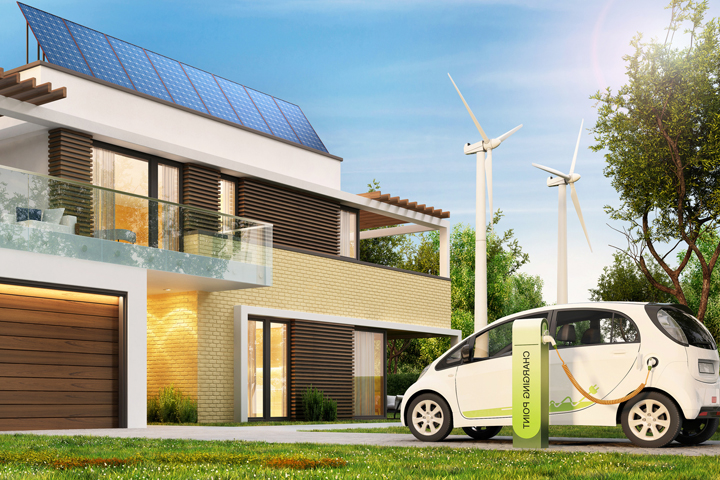Anchoring a Society of Energy Adaptationists
Operators of energy networks can now capitalize on the increasing adoption of renewable energy sources to make their network more environmentally friendly. However, while a greener network is favorable, it may not always be robust. Hence, operators are constantly exploring strategies to construct a more robust and dependable grid. One remarkable opportunity arises from the proliferation of household photovoltaic (PV) systems that produce electricity for personal use in private residences. Both PV-equipped households and the network benefit from this trend as the former can supply excess power to the latter.
Households that vend their surplus electricity to the grid, also known as “prosumers,” can store extra electricity either in stationary batteries or the battery of their electric vehicle. By adding battery storage capability, prosumers gain the freedom to charge and discharge batteries according to their specific goals. Consequently, these “prosumers” transform into “flexsumers,” managing the utilization of their batteries based solely on their personal energy consumption and PV production needs.

At present, PV households cannot operate entirely autonomously from the power network. In the winter season, the power grid must provide a residual amount of electricity to these households. However, during sunny periods, they can still trade surplus energy with the network.
What if they could exchange this residual energy locally within their community? Would the power network experience reduced strain from peak energy injections on sunny days? Could all residual energy be locally swapped?
To address these inquiries, a real-world initiative named BASE.V was initiated in Germany. As per Martin Jenkner, the project manager at Moxa Europe for BASE.V, this flexibility, enabled through pooling storage capabilities, also acts as a valuable buffer against distribution grid congestion and bottlenecks during peak demand intervals. As the networks of flexsumer households increase their independence in energy, they can enhance energy resilience and network stability without significant investments in grid capacity or infrastructure.
Examining the Functionalities of Flexsumers in a Practical Setting
Carried out by a research group from the Technical University of Munich and financially supported by a government subsidy and private sponsorships, BASE.V ran for a duration of six months. Seven households in Dietfurt, Bavaria, Germany—each equipped with a PV system, stationary battery storage, and an electric vehicle with a charging station—took part in the project.
Participant households had the opportunity to purchase or sell electricity through a peer-to-peer trading platform. They executed personalized trading agreements via intelligent contracts processed through an Industrial Internet of Things (IIoT) gateway from Moxa, a specialist in network communications.
The insights gathered from the BASE.V initiative demonstrated that electricity trading between individual households could help mitigate the inherent fluctuations in solar energy generation and the transient spikes in electricity consumption without compromising network stability.
Establishing Interconnections between the Fundamental Units
A decentralized ledger and data security, enabled by blockchain technology, facilitate peer-to-peer energy exchange. As trading counterparts, flexsumer households can execute blockchain-driven smart agreements without relying on a trusted intermediary. For the BASE.V study, program data and bespoke information were stored in blockchains as part of a secure, dependable, and scalable network architecture, leveraging Moxa’s IIoT gateway.
Kyle Hsieh, the IIoT and Blockchain network engineer at Moxa, emphasized the importance of establishing a suitable blockchain network for the BASE.V initiative. Quorum, a selective blockchain network, was chosen as the project’s blockchain framework due to its minimal footprint on the IIoT gateway to conserve system resources. Through containerization supported by Moxa’s IIoT gateway, developers leveraged a hybrid platform to deploy software on both cloud and edge environments for task-specific purposes. The same versatility extended to hybrid networks, accommodating multiple network-specific applications on a single device.
For example, Moxa’s IIoT gateway can handle blockchain nodes (referred to as light nodes) to synchronize trade transactions between households and the cloud. Additionally, the Energy Management System (EMS) inside runs an optimization algorithm to predict energy generation and consumption. Lastly, an Internet of Things (IoT) client assists operators in managing the IIoT gateway from the cloud throughout its life cycle. With this setup, customers can easily follow instructions to connect to the gateway. Virtual private networks (VPNs) readily support remote monitoring and troubleshooting, minimizing the need for on-site technical support visits.

Regarding the operational performance of IIoT, Moxa’s developers successfully configured system resources to reduce CPU processing time to align with the specifications of the BASE.V study. Energy trading takes place within a 15-minute interval. Hsieh elaborated, “Our initial challenge was to streamline the computation time required to run the optimization algorithm on the ARM-based computer. Eventually, we enhanced it from 22 minutes to 22 seconds, thanks to the adaptable configuration and robust processors. Moxa’s IIoT gateways met the demand for swift execution of energy trading.”
An In-Depth Analysis of Our Communication and Data Strategy
The BASE.V initiative is a futuristic study evaluating whether offering economic incentives like peer-to-peer renewable energy exchange among prosumer households can encourage energy self-sufficiency. The successful and widespread implementation of energy trading alleviates grid congestion, thereby fostering network stability and energy resilience.
To delve deeper into efficient energy trading and management, explore the webinar recording for detailed insights on the BASE.V project and the Moxa IIoT solutions utilized for blockchain-based peer-to-peer energy trading.
- Not Only for Automobiles: Discovering CANbus Technology in Various Industrial Settings - October 29, 2024
- Boost Your Network Performance: An Exciting Manual to PoE Switches! - September 10, 2024
- Understanding Gigabit Switches: Industrial vs Regular Gigabit - September 4, 2024


